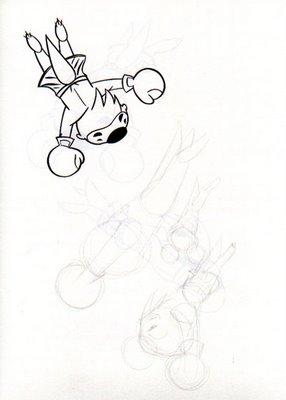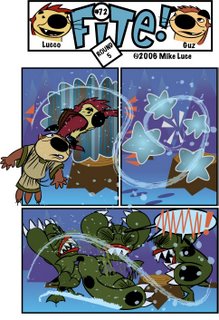So, since no one asked, this is how I go about putting an episode of Fite! together. First I start out with a very rough sketch, usually on a piece of scrap paper. The looser the better. All I want here is the general sense of how the page will be set up and what the characters will be doing. I usually only have to do one of these, but sometimes, with trickier layouts, I do more. For episode 52, this is what I started with:

Now that I have that down, I go to the sketch pad and work on the figures in pencil. Once I have the ones I need, I ink the ones I like using a brush and Speedball ink (which has become almost like pudding and smells like fish). I like to draw the whole figure even though most are likely to be edited for their panel later on. Backgrounds are not sketched The finished, inked drawings are scanned and edited for smudges and the like:




Once I have the images scanned, I open a fite! blank in Illustrator (this is just a white page with only the logo at the top and a simple box that keeps the shape and size of the strip standard). I then set up the panels as they appeared in the sketch:

The next step is to 'place' each figure onto a separate layer in Illustrator and convert the jpegs to vectors using the 'livetrace' feature (I love this part). Here, I resize the figures to fit the panels then cut and crop the extra bits where needed. I often lose a lot of the figure this way, but I feel the drawings look more full if I depict the whole character instead of guessing which parts will show and which won't. Eventually, I end up with a black and white outline of the comic:

The next step is to add color, which I do from below the black and white drawings. While it's not difficult to color the characters, it's time consuming. I also do backgrounds in this step (though there really aren't any in this particular episode). I generally know what I want, but to try and keep things a little fresher, I don't sketch these out ahead of time. This might be a mistake but for now, this is how it goes. This is a screen shot of what the color layer looks like without the drawings showing:

Finally, I go back and fix mistakes and add any special effects that might need to be on different layers, such as the contrails in this episode:

That's about it. Some episodes take more planning than others. Some require that I pose for some reference photos to get positions and details right (I need to do more of this). Part of doing a strip, I think, is getting the flow down so that one can just do the work without having to think about the process.





















